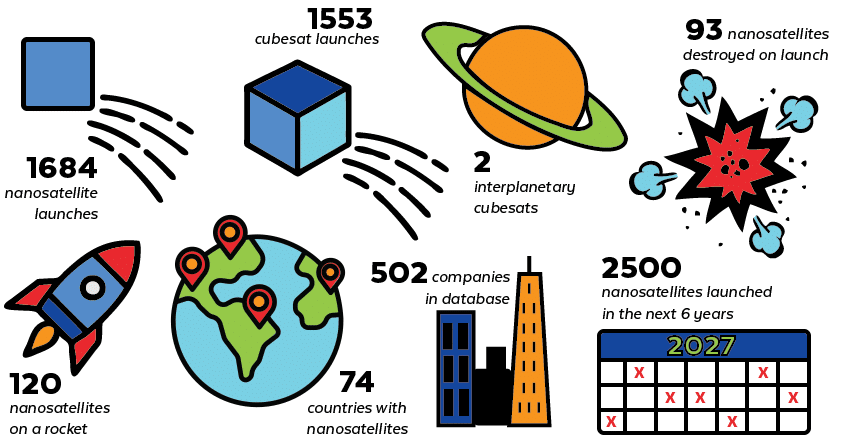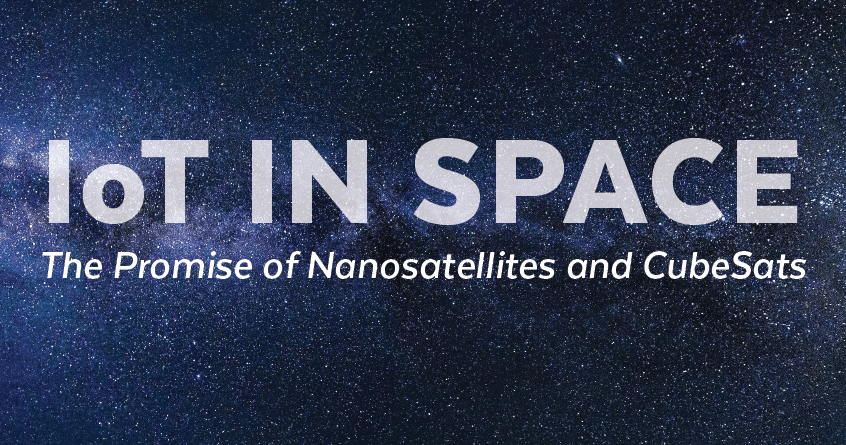The Internet of Things (IoT) has captured the imaginations of government space agencies and private space industries alike. As a result, IoT is no longer earthbound.
One of the most interesting IoT space endeavors in the works today is the use of constellations of low-cost, low-flying “nanosatellites” to collect data from the remotest parts of the world. This vision includes data collection from ships at sea, solar-powered vehicles in Antarctica, or even tracking roaming herds of animals in Africa.
What Does IoT in Space Mean?
The Internet of Things is the connection of intelligent devices to the internet or other connected devices.
But what does “IoT in space” mean?
According to Professor Johann-Dietrich Worner, Director General of the European Space Agency (ESA):
The Internet of Things is based on data transmission between sensors and devices. These data can be transmitted terrestrially or even through space. This is particularly important wherever there is a lack of good network coverage on Earth: in remote areas, for example, or when transporting goods on trains or in container ships. Space can act as a kind of transmission bridge with the help of satellites, thus enabling data transfer at any time. Space is, therefore, a great enabler of IoT.
NASA Sends Nanosatellites to Space
On June 3, 2019, NASA deployed satellite “sprites” called ChipSats (nanosatellites) into Earth’s orbit. These tiny satellites are square-shaped and measure 3.5X3.5 centimeters, making them just a bit larger than a postage stamp. This initial deployment’s goal was to test the satellites’ ability to communicate with each other and transmit data back to Earth.
This project aims to build a swarm of these ChipSats to provide a lower-cost way to gather information about our planet’s weather, environment, and wildlife. Beyond that, there is the potential for them to map the surface of asteroids and moons traveling around other planets.
The Private Sector and Nanosatellites
Along with NASA and other government-run space agencies, there are many companies around the world promising low-cost, low-flying “nanosatellites.” These companies are focused on two main things: 1) low-bandwidth, low-cost data collection networks and 2) who has global licenses and who does not. After that, each company’s approach diverges substantially.
Six of the top nanosatellite companies are:
- Alen Space (Spain)
- Astrocast SA (Switzerland)
- Clyde SpaceLimited (United Kingdom)
- Crest Astra (Japan)
- Hera Systems (USA)
- Orora Tech (Germany)
So, Just What is a Nanosatellite?
Any satellite that weighs less than 10 kilograms (approximately 22 pounds) is a nanosatellite. The term “nanosatellite” is a mass classification covering CubeSats, PocketQubes, TubeSats, SunCubes, ThinSats, and non-standard picosatellites, all of which are part of the same CubeSat standard of technology as defined by the CubeSat Design Specification (CSD).
CubeSats
CubeSats come in different sizes, but all are based on the standard CubeSat unit, a cube-shaped structure that measures 10X10X10 centimeters (approximately 4X4X4 inches). This standard unit is labeled 1U. CubeSats dimensions can range from 0.25U to 27U, with new configurations in constant development.
A Bit of History of the CubeSat
The CubeSat standard was developed in 1999 by California Polytechnic State University, San Luis Obispo, partnering with Standard University’s Space Systems Development Lab. Professors Jordi Puig-Suari (Cal Poly) and Bob Twiggs (Stanford) wanted to enable their graduate students to design, build, test, and operate small satellites with limited capabilities that could fit within the constraints of time and money in a graduate degree program.
In 2014, Bob Twiggs reminisced about the project:
The early launch providers were Russian. We did go to some of the American launch providers, Lockheed Martin comes to mind, and they said, “If you give us a half-million dollars, we’ll study it, and then if it makes economic sense for us to launch it, we’ll do it.” We kept asking them to take some of the lead (ballast) off and fly some of these things as secondaries, but they just didn’t go along with it. I was really disappointed that the aerospace industry couldn’t see the benefit other than profits from it. They couldn’t see the educational benefit from it and the potential of the educational benefit turning into commercial application. Now, you see the commercial applications coming along with Skybox Imaging with Planet Labs. Oh my goodness, they look like they have tremendous economic potential.
The first CubeSats were launched into orbit by a Russian Eurocket in June 2003. From then until 2013, most CubeSat launches were for educational purposes. After that, CubeSats and other nanosatellites have become a vital part of the aerospace industry and its commercial satellite expansion. In fact, as of April 2021, 1553 Cubesats have been launched into orbit. Some of the most prominent nanosatellite uses are:
- Planet Lab’s dozens of CubeSat-sized Dove satellites in orbit, as well as a few RapidEye CubeSats, which are used in everything from disaster response to climate monitoring
- The International Space Station’s (ISS) NanoRacks CubeSat Deployer that launces CubeSats that have been hauled to orbit aboard an ISS vehicle
- NASA’s CubeSat Launch Initiative (CLSI) that provides opportunities for small satellites to fly aboard rockets planned for traditional launches
How Many Nanosatellites Are In Orbit?
Here are some facts from the Nanosats Database as of April 4, 2021:
- Number of nanosatellites launches: 1684
- Number of CubeSat launches: 1553
- Interplanetary CubeSats: 2
- Number of nanosatellites destroyed on launch: 93
- Most nanosatellites on a rocket: 120
- Number of countries with nanosatellites: 74
- Number of companies in database: 502
- Forecast: Over 2500 nanosatellites to be launched in the next six years
 Predictions for the Future
Predictions for the Future
Leading NewSpace company, Alen, has made the following predictions about small satellites:
- An increase in the number of launches: Between 513 and 745 launches are projected in 2023. If this happens, the number of launched nanosatellites will have doubled during the five years from 2018 to 2023.
- A more prominent role for larger CubeSats (6U and 12U): There is a growing need for these larger CubeSats because they have greater data and transmission capacity, artificial intellIgence, propulsion systems, etc.
- Larger constellations and improved coordination between CubeSats
- A transformation of nanosatellite technology thanks to artificial intelligence (AI): AI will help to simplify the management of all tasks associated with small satellite control and the services they provide
- Greater data processing and transmission capacity
- Increased use of propulsion systems for CubeSats: The use of electric, chemical, or water propellants will allow CubeSats to move in a more controlled and deliberate way.
- Improvement in active and passive de-orbiting systems: Space junk is a real concern, and there is a growing effort to improve de-orbiting systems that will help declutter space.
- High-tech solutions for antennas: Small satellites have space issues. Innovative measures are underway to face this problem. Alen explains, “For example, there are already missions such as NASA’s RainCube project, which apply the Japanese art of origami in this field. The parabolic antennas are folded to occupy as little space as possible and are only unfurled once in orbit.”
- Increased use of CubeSats for space exploration: MarCO A and B, the first two CubeSats to travel into deep space, were launched in 2018. And the ESA has two CubeSats 6U as part of their Hera mission to travel to the Didymos asteroid.
- New regulations: An increase of nanosatellites will require new rules to ensure safety, quality, cyber-security, and de-orbiting.
Last Words
The nanosatellite sector seems to be an inexhaustible source of business opportunities and promises of new and exciting technological advances. We truly hope you found this article informative. Versa Technology delivers high-quality networking technologies to IT professionals around the world. Our unwavering goal is to provide the best support to help our customers achieve their computer networking goals. To view our Power over Ethernet products and services, visit the Versa Technology homepage.

